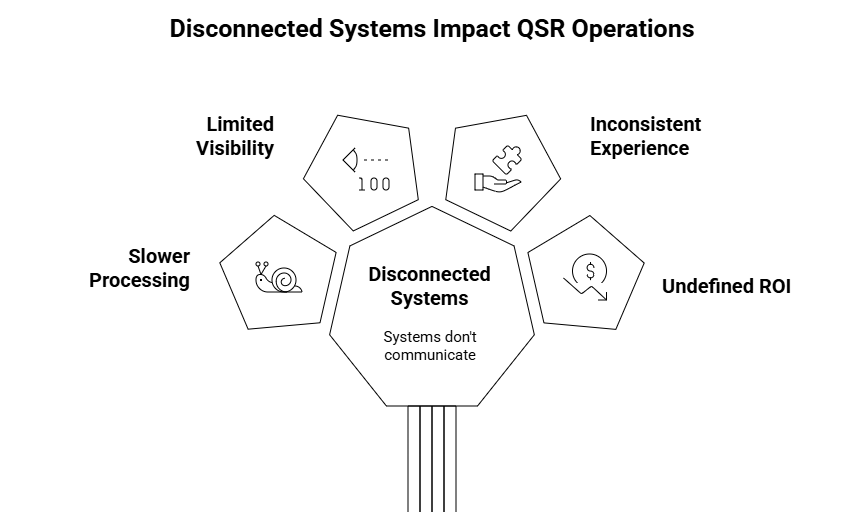Quick Service Restaurants (QSRs) have evolved far beyond the traditional model of fast food delivery. Today, the industry thrives on digital precision, where guest experience, service speed, and operational throughput are all shaped by technology. From AI-driven order management and mobile app personalization to smart kitchens and predictive analytics, every second in a QSR now depends on how efficiently technology performs.
But with rapid digital adoption comes fragmentation. Many QSR brands operate multiple systems, often running on different infrastructures. This lack of synchronization leads to delays, data silos, and inconsistent guest experiences across outlets and regions.
In such a high-volume, experience-driven business, guessing which technologies work best isn’t an option. Technology benchmarking brings objectivity to this decision-making, comparing digital tools, platforms, and processes across brands, markets, and operational environments. It identifies what truly drives service excellence, throughput optimization, and customer loyalty.
The Challenge: Fragmented Technology Adoption in the QSR Industry
Despite being one of the fastest adopters of digital innovation, the QSR industry continues to struggle with fragmented technology ecosystems that hinder speed, efficiency, and customer experience. Most restaurant chains have implemented technologies in isolation, without cohesive benchmarking or integration frameworks to evaluate performance across touchpoints.
Here are the key challenges shaping this fragmentation:

- Disconnected Front-End and Back-End Systems: Many QSRs operate multiple POS systems, aggregator APIs, and kitchen automation tools that don’t communicate seamlessly. This lack of synchronization leads to slower order processing, data duplication, and inconsistent reporting.
- Limited Throughput Visibility: Few operators track end-to-end service efficiency from order placement to fulfillment. Without comparative benchmarks for average service time, prep duration, and order accuracy, optimization opportunities remain hidden.
- Inconsistent Guest Experience Across Channels: Mobile apps, self-ordering kiosks, and in-store touchpoints often offer different experiences. The absence of unified customer analytics prevents brands from maintaining consistent service personalization and loyalty engagement.
- High CapEx with Undefined ROI: Many QSRs invest heavily in new technologies, without a clear understanding of their measurable contribution to revenue, speed, or retention.
The result is a digital efficiency paradox, where technology adoption rises, but performance impact remains unclear. To overcome this, QSRs need a structured approach to evaluate digital tools objectively, benchmark them against industry leaders, and realign investments toward technologies that directly enhance guest experience, throughput, and profitability.
Nexdigm’s QSR Technology Benchmarking Framework
Technology adoption in the QSR industry is a strategic necessity. Yet, without structured evaluation, investments in automation, ordering systems, or digital engagement tools can easily underdeliver. Nexdigm’s QSR Technology Benchmarking Framework brings clarity, precision, and measurability to every aspect of restaurant technology adoption.
Designed specifically for quick service and fast-casual restaurant chains, the framework integrates competitive intelligence, operational analytics, and ROI benchmarking to help brands identify which technologies enhance guest experience, accelerate service, and optimize throughput at scale.
Core Components of the Framework
- Digital Ordering and Front-End Experience Analysis: Nexdigm benchmarks customer-facing technologies such as mobile apps, self-ordering kiosks, drive-thru systems, and loyalty programs, evaluating their speed, ease of use, and integration effectiveness. This identifies which tools genuinely improve convenience and conversion.
- POS and Transaction System Benchmarking: We assess point-of-sale (POS) platforms across metrics like transaction speed, uptime reliability, and integration with delivery aggregators and CRM systems, helping QSRs optimize order flow and reduce wait times.
- Kitchen Automation and Back-End Optimization: Nexdigm measures the performance of smart kitchen systems, order sequencing software, and robotic automation, benchmarking their impact on order accuracy, preparation time, and staff productivity.
- Delivery and Aggregator Integration Assessment: With delivery platforms now contributing up to half of QSR revenue in some markets, we evaluate integration speed, order synchronization, and API performance to enhance delivery throughput and customer satisfaction.
- Data Analytics and Operational Intelligence: Our benchmarking compares how QSRs utilize real-time data analytics, AI forecasting, and performance dashboards to predict demand, optimize staffing, and reduce wastage.
- ROI and Performance Mapping: Finally, Nexdigm synthesizes all insights into a custom benchmarking dashboard, correlating technology efficiency with financial and operational KPIs such as revenue per store, order turnaround time, and guest satisfaction index.
By aligning every touchpoint, Nexdigm helps QSR brands transform fragmented tech stacks into cohesive, high-performance systems. The result: faster service, happier customers, and a stronger bottom line driven by measurable technology ROI.
To take the next step, simply visit our Request a Consultation page and share your requirements with us.
Harsh Mittal
+91-8422857704

